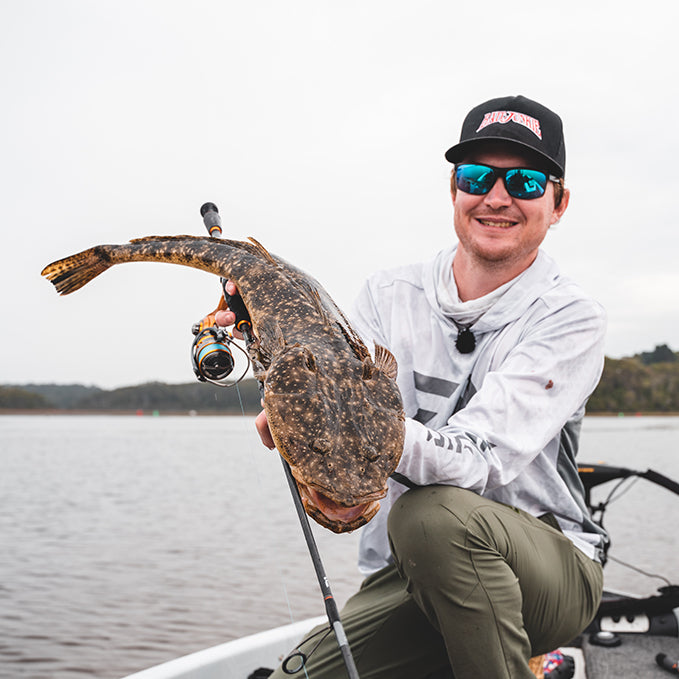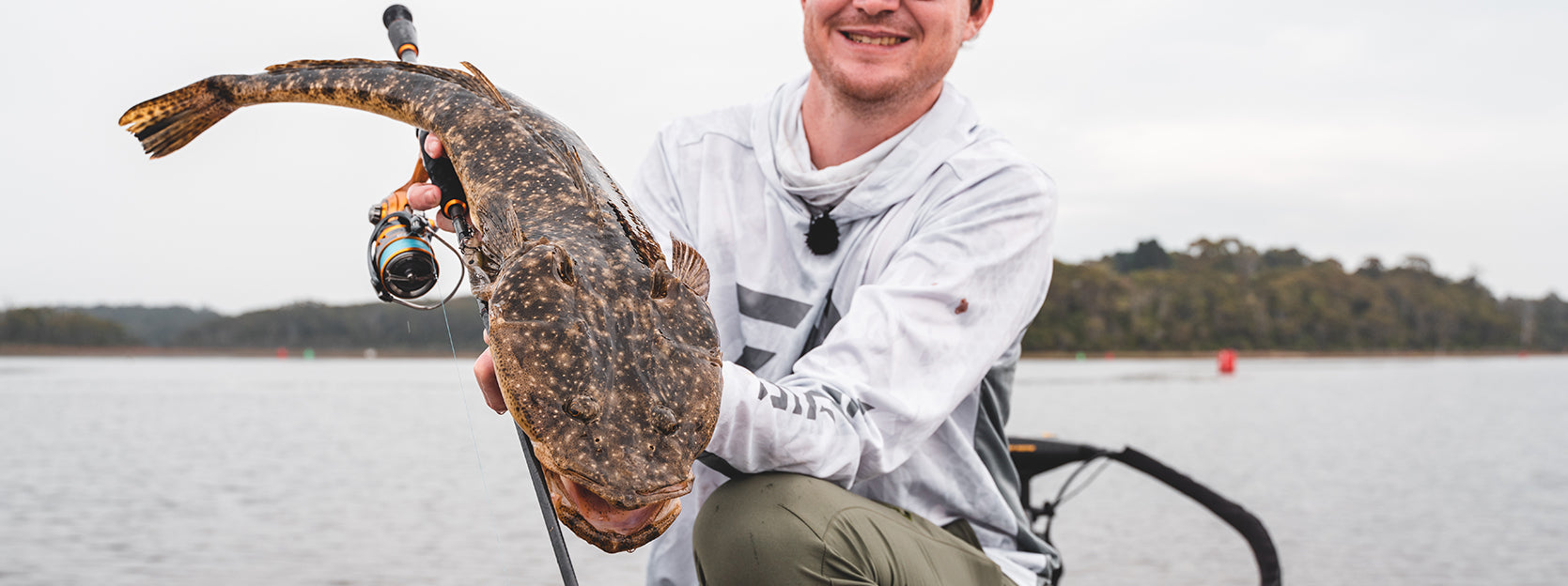Posted 15th September 2023
How to Catch Flathead on Bait (Flathead Series)


By Robert Thornton
In the final instalment of our flathead series, we’re going to go back to basics and look at how to catch flathead on bait. Bait fishing is still an extremely effective method for landing a lizard – especially a larger one – but to do it well involves more than just rocking up to the waterhole, lobbing a bait in and waiting. Sure, you can certainly catch them by mindlessly soaking a bait down at the local estuary, but to get consistent results you’ll want to employ a bit of lure methodology. Similarly, bait fishing can teach us so much that we can apply to our lure fishing as well.
The bottom line is that bait fishing for flathead is a worthy skill, and well worth understanding if you want to become a better flathead angler. In this blog we’ll cover a bit of background on bait fishing for flathead, and then we’ll discuss bait, rigs, specific techniques and tackle.
Bait Background
Like most flathead related things, bait fishing for them goes back many decades. Various bait techniques were popular throughout the twentieth century; however the advent of lures and particularly soft plastics has seen bait take a bit of a back seat. It’s no secret that lures are an incredibly effective presentation for flatties – so much so that I would argue that if numbers are your aim, lures are the tool to use. For selectively targeting the bigger, older and smarter models prowling around the estuaries though, there aren’t many things more deadly than a meticulously rigged live bait or animated dead bait.
We all know about the big bait craze taking the flathead world by storm, but it’s worth remembering that these giant creations are mimicking the large live baits that big flathead hunters used to use. The nice thing about a live bait though – or any bait for that matter – is that it feels real, because it is real. If there’s a big flathead in the area, you’ll have a better shot at getting that fish to eat, and more importantly, keeping it connected.
In years gone by anglers would use clunky reels with heavy nylon mounted on sloppy fibreglass rods. Wire traces were virtually compulsory to prevent bite-offs, and many of the bigger models were kept for the table. Times have changed though, and not only has the preferred tackle shifted, but also the conservational practises of the average angler. There are a few things, however, that haven’t changed much at all. The same flathead baits are still fished in same the locations for more or less the same results, and this is a testament to just how effective this technique is when done properly.
Live or Dead?
Both live and dead baits will work on flatties, and there are pros and cons to both. First up we’ll examine dead baits.
A dead bait for flathead can be anything meaty, and I’ve seen these fish inhale everything from whole frozen pilchards to salami. The best dead baits, however, are usually flesh strips or whole fish rigged so they can be worked without spinning or moving unnaturally.
Effective dead baits for flatties include, but are certainly not limited to, whole pilchards, gar, whitebait and herring, mullet fillets and squid strips. The ideal size depends on the size of the fish you wish to target, but generally a 6-10cm baits is fine for most occasions.
Whole fish type baits are best rigged with a single hook pinned through the eyes laterally or through the jaw vertically, or with 2-3 ganged hooks pinned along the body. The idea is for the bait to stay straight in the current and when being retrieved slowly.
Rigging flesh or strip baits is similar, however you may need to shape your bait so that it’s symmetrical and streamlined, once again to keep it ‘swimming’ naturally.
The reason why moving your dead baits is important is because large dead baits will attract unwanted pickers and crustaceans if left to sit motionless on the bottom. Movement imparted by the angler will make the bait less appealing to these undesirables and more to the liking of predators like flathead.
Anglers also have a lot of freedom with live bait selection, but the tried-and-true favourites for big flathead chasers include poddy mullet, gar, herring, tailor, summer whiting, prawns and even small squid. Generally, livies should be rigged to allow the bait maximum movement, and one hook is enough for smaller baits between 6-10cm. Snelled double-hook rigs are a good idea if using baits larger than about 10cm, but care should be taken to leave a small amount of slack in the trace between the two hooks when rigged up, as this will allow the live bait to swim freely. Single hooks can go through the eyes or jaw of fish, the tail for prawns and the top of the hood for squid. If there’s a second hook, the best place for it is through the tail wrist for fish and the bottom of the hood just above the tentacles for squid. The second hook can also be left to swing free, and some anglers prefer this presentation.

Bait Rigs
There are infinite rigs that will suffice for this relatively undiscerning quarry, but in the spirit of pragmatism, we’ll go through a couple of the most user-friendly.
For your basic terminals, there’s no need to go extra heavy. In days gone by wire traces were standard, however wires are known to deter even some of the bolder predators, plus the extra weight can restrict bait movement. The best way to avoid hooking fish deep, and therefore reducing the risk of bite-offs, is to run circle hooks. Anything between 1/0-5/0 (depending on the bait size) is fine, just remember that when using circles there is no need to strike or set the hook. Gradually increasing the pressure once a bite is detected very rarely results in anything other than a perfect corner-of-the-jaw hook-up.
Corner jaw hook-ups allow you to safely run lighter traces, and 10-20lb monofilaments or fluorocarbons are ideal. Fluorocarbon like J-Thread FC will have less profile in the water, which is a real advantage in clear water. Monofilament such as J-Thread Nylon has better abrasion resistant properties, and is more buoyant in the water, giving smaller live baits slightly better range of movement.
If you’re running gangs, there shouldn’t be any need to run wire or an extra-heavy mono trace, as the gangs themselves act as a trace, so anything heavier than 20lb is unnecessary.
Sinkers and swivels certainly have their uses but aren’t necessary. Baits can be fished unweighed in shallow water or where there isn’t much current. Fishing them this way will allow them to present more naturally, however sometimes there is a need to get them down if you’re in a deep hole or the current is strong.
A ball sinker above the swivel (with a trace between 30-50cm) is the way to go, as it won’t drag the bait itself straight to the bottom, instead letting it waft or swim just off the bottom.
How to Catch Flathead on Bait
As I’ve mentioned, the key to successful bait fishing for flathead is movement, so let’s unpack that a little, starting with dead baits.
So you’ve got your whole fish or strip bait rigged and ready –what should you do with it? The short answer is to throw it where flathead might be, and that could be over a nice looking flat, at the mouth of a drain, on the edge of a weed bed, into a surf gutter, or even out into a sandy channel across the current.
Once it sinks or wafts down to within a few feet of the bottom, or on the bottom itself, you can commence the trickery. Some anglers will wind their bait very, very slowly all the way back to the boat, repeating this process until they’ve covered an area over. Others will use the rod tip to really animate the bait to make it look like it’s fleeing danger (like you would with a soft plastic), leaving long periods in between for it to gradually make its way back to the bottom. Rigs with sinkers can be useful for not only keeping the bait near the bottom in stronger currents, but also puffing up bits of sand and acting as a second attractant.

How to Catch Flathead on Live Bait
With livies, the bait itself should provide sufficient movement. With this in mind, there’s no sense in casting and retrieving a live bait, as the repeated casting and landing on the water will only shorten its life. You’re far better off positioning yourself or your boat in an area where you know larger flathead will be sitting. Creek mouths, the edge of drop-offs, and any areas that funnel bait are good areas to send a live bait in.
When fishing with live baits it’s important to give your bait some time to soak, but it’s not always a good idea to spend hours in one spot if there’s no action. Give each area you try at least 20-30 minutes before moving on. Flathead may move into your area at a certain stage of the tide, but you’re more likely to find fish if you try at least a few spots each trip.
Tackle Talk
You don’t need specific gear to target flatties on bait, but Daiwa has a few handy products that lend themselves perfectly to this caper.
A Free Swimmer BR LT spin reel is a fantastic investment for not just flathead anglers, but anyone who likes to fish with live baits and large dead baits. The Bite’N’Run function allows fish to take line with minimal tension, which can be adjusted by turning the knob on the rear of the reel. This is perfect for fish like flathead that often play with their food before eating it properly, and the reel will engage as soon as the handle is wound forward.
Rods similarly don’t need to be anything special, and a nice sturdy composite blank design like the Crossfire is ideal. This range is great bang for buck, and all the models have the sensitivity needed for bait fishing, but also feature a crisp action for pinning flatties should you need to set the hook. The Crossfire 702MFS is a great pick for either large dead baits or livies.
Flat Out Baiting
So, as you can see, there is a lot more to bait fishing for flathead than a lot of people might think, and it stands as one of if not the best way to land a really big specimen. Sure, it isn’t as popular as it used to be, but there will always be a community of clued-in anglers that call upon this tried-and-true method!
















